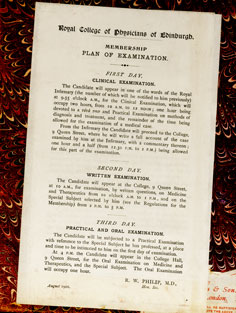Membership Examinations

In search of standardisation By the early 1960s there was growing concern about the standard of performance of a very large proportion of entrants. Our sister Colleges in London and Glasgow shared the Edinburgh anxiety and the subject became an issue for joint consultation by all three medical colleges. There was agreement that membership should be a reflection of a junior doctor’s ability ‘to become a specialist or consultant after further training’. The emphasis on ‘further training’ had been lost on some MRCP Edin candidates in their belief that the Edinburgh membership, with a chosen specialty as a subsidiary part of the examination, conferred proof of acquired specialist status. Unification made it unnecessary for trainees to enter several membership examinations and guaranteed that the standards of entry to the membership of the three Colleges were identical. The specialist subject requirement of MRCP Edin was dropped and in October 1968 the first joint Part 1 Examination was launched. Since then the MRCP(UK) has evolved to develop into the three-college, three-part examination that is recognised globally today as a benchmark of medical knowledge and clinical skills. That evolution and search for standardisation included a complete revision of the clinical examination, switching from the long and short cases and the stand-alone oral component of the clinical exam to the Objective Structure Clinical Examination-style Practical Assessment of Clinical Examination Skills (PACES). |


 In
the late 1960s the need to have a single recognised examination throughout
the UK was recognised.
In
the late 1960s the need to have a single recognised examination throughout
the UK was recognised.